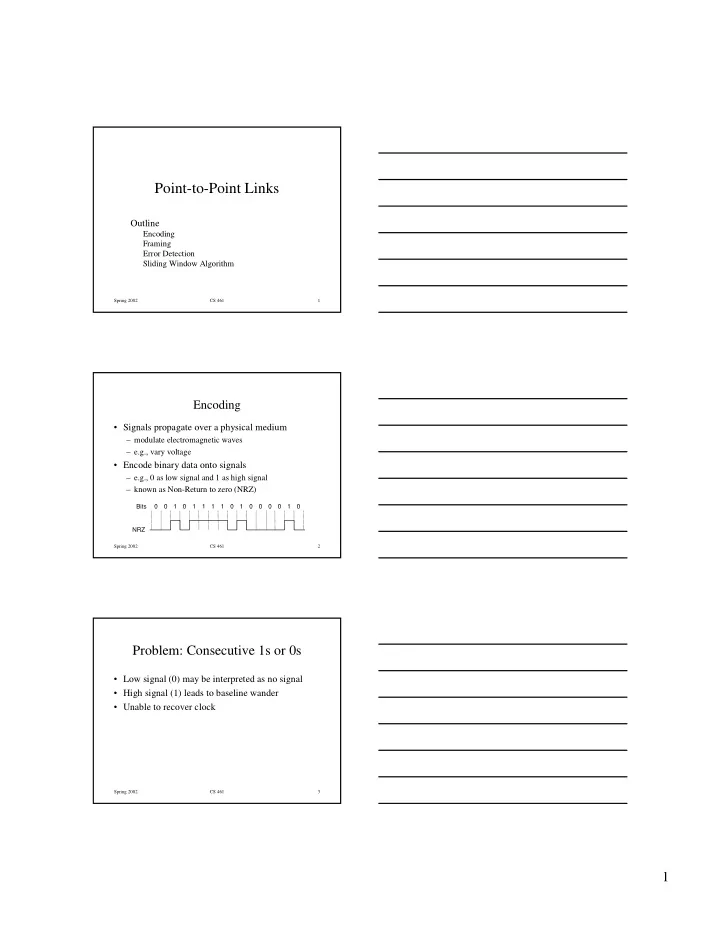

Point-to-Point�Links Outline Encoding Framing Error�Detection Sliding�Window�Algorithm Spring�2002 CS�461 1 Encoding • Signals�propagate�over�a�physical�medium – modulate�electromagnetic�waves – e.g.,�vary�voltage • Encode�binary�data�onto�signals – e.g.,�0�as�low�signal�and�1�as�high�signal – known�as�Non-Return�to�zero�(NRZ) Bits 0 0 1 0 1 1 1 1 0 1 0 0 0 0 1 0 NRZ Spring�2002 CS�461 2 Problem:�Consecutive�1s�or�0s • Low�signal�(0)�may�be�interpreted�as�no�signal • High�signal�(1)�leads�to�baseline�wander • Unable�to�recover�clock Spring�2002 CS�461 3 1
Alternative�Encodings • Non-return�to�Zero�Inverted�(NRZI) – make�a�transition�from�current�signal�to�encode�a�one;� stay�at�current�signal�to�encode�a�zero – solves�the�problem�of�consecutive�ones • Manchester – transmit�XOR�of�the�NRZ�encoded�data�and�the�clock – only�50%�efficient�(bit�rate�=�1/2�baud�rate) Spring�2002 CS�461 4 Encodings (cont) • 4B/5B – every�4�bits�of�data�encoded�in�a�5-bit�code – 5-bit�codes�selected�to�have�no�more�than�one�leading�0� and�no�more�than�two�trailing�0s� – thus,��never�get�more�than�three�consecutive�0s – resulting�5-bit�codes�are�transmitted�using�NRZI� – achieves�80%�efficiency Spring�2002 CS�461 5 Encodings�(cont) Bits 0 0 1 0 1 1 1 1 0 1 0 0 0 0 1 0 NRZ Clock Manchester NRZI Spring�2002 CS�461 6 2
Framing • Break�sequence�of�bits�into�a�frame • Typically�implemented�by�network�adaptor Bits Node�A Adaptor Adaptor Node�B Frames Spring�2002 CS�461 7 Approaches • Sentinel-based – delineate�frame�with��special�pattern:�01111110 – e.g.,�HDLC,�SDLC,�PPP 8 16 16 8 Beginning Ending Header Body CRC sequence sequence – problem:�special�pattern�appears�in�the�payload – solution:� bit�stuffing • sender:�insert�0�after�five�consecutive�1s • receiver:�delete�0�that�follows�five�consecutive�1s Spring�2002 CS�461 8 Approaches�(cont) • Couter-based – include�payload�length�in�header – e.g.,�DDCMP 8 8 8 14 42 16 Class SYN SYN Count Header Body CRC – problem:�count�field�corrupted – solution:�catch�when�CRC�fails Spring�2002 CS�461 9 3
Approaches�(cont) • Clock-based – each�frame�is�125us�long – e.g.,�SONET:�Synchronous�Optical�Network – STS- n (STS-1�=�51.84�Mbps) Overhead Payload Hdr Hdr Hdr STS-1 STS-1 STS-1 9�rows Hdr STS-3c 90�columns Spring�2002 CS�461 10 Cyclic�Redundancy�Check • Add� k� bits�of�redundant�data�to�an� n -bit�message – want� k <<� n – e.g.,� k =�32�and� n =�12,000�(1500�bytes) • Represent� n -bit�message�as� n -1�degree�polynomial – e.g.,�MSG=10011010�as� M ( x )�=� x 7 +� x 4� +� x 3 +� x 1 • Let� k be�the�degree�of�some�divisor�polynomial – e.g.,� C ( x )�=� x 3 +� x 2 +�1 Spring�2002 CS�461 11 CRC�(cont) • Transmit�polynomial� P ( x )�that�is�evenly�divisible� by� C ( x )� – shift�left� k bits,�i.e.,� M ( x ) x k – subtract�remainder�of� M ( x ) x k /� C ( x )�from� M ( x ) x k • Receiver�polynomial� P ( x )�+� E ( x ) – E ( x )�=�0�implies�no�errors • Divide�( P ( x )�+� E ( x ))�by� C ( x );�remainder�zero�if: – E ( x )�was�zero�(no�error),�or – E ( x )�is�exactly�divisible�by� C ( x ) Spring�2002 CS�461 12 4
Selecting� C ( x ) • All�single-bit�errors,�as�long�as�the� x k and� x 0 terms�have� non-zero�coefficients. • All�double-bit�errors,�as�long�as� C ( x )�contains�a�factor�with� at�least�three�terms • Any�odd�number�of�errors,�as�long�as� C ( x )�contains�the� factor�( x +�1) • Any�‘burst’�error�(i.e.,�sequence�of�consecutive�error�bits)� for�which�the�length�of�the�burst�is�less�than� k bits. • Most�burst�errors�of�larger�than� k bits�can�also�be�detected • See�Table�2.6�on�page�102�for�common� C(x) Spring�2002 CS�461 13 Internet�Checksum�Algorithm • View�message�as�a�sequence�of�16-bit�integers;�sum�using� 16-bit�ones-complement�arithmetic;�take�ones-complement� of�the�result. u_short cksum(u_short�*buf, int count) { register�u_long�sum�=�0; while�(count--) {����������� sum�+=�*buf++;����������� if�(sum�&�0xFFFF0000)������������ {��������������� /*�carry�occurred,�so�wrap�around�*/������������� sum�&=�0xFFFF;��������������� sum++;����������� }������� }������� return�~(sum�&�0xFFFF); } Spring�2002 CS�461 14 Acknowledgements�&�Timeouts Sender Receiver Sender Receiver Frame Frame Timeout Timeout Time ACK ACK Frame Timeout ACK (a) (c) Sender Receiver Sender Receiver Frame Frame Timeout Timeout ACK Frame Timeout Frame Timeout ACK ACK (b) (d) Spring�2002 CS�461 15 5
Stop-and-Wait Sender Receiver • Problem:�keeping�the�pipe�full • Example – 1.5Mbps�link� x 45ms�RTT�=�67.5Kb�(8KB) – 1KB�frames�implies�1/8th�link�utilization� Spring�2002 CS�461 16 Sliding�Window • Allow�multiple�outstanding�(un-ACKed)�frames • Upper�bound�on�un-ACKed�frames,�called� window Sender Receiver … Time … Spring�2002 CS�461 17 SW:�Sender • Assign�sequence�number�to�each�frame�( SeqNum ) • Maintain�three�state�variables: – send�window�size�( SWS ) – last�acknowledgment�received�( LAR ) – last�frame�sent�( LFS ) • Maintain�invariant:� LFS - LAR <=� SWS ≤ SWS … … LAR LFS • Advance� LAR when�ACK�arrives� • Buffer�up�to� SWS frames Spring�2002 CS�461 18 6
SW:�Receiver • Maintain�three�state�variables – receive�window�size�( RWS ) – largest�frame�acceptable�( LFA ) – last�frame�received�( NFE ) • Maintain�invariant:� LFA - LFR <=� RWS ≤ RWS … … NFE LFA • Frame� SeqNum arrives: – if� LFR <� SeqNum <�=� LFA accept – if� SeqNum <�=� LFR or� SeqNum >� LFA discarded • Send�cumulative�ACKs� Spring�2002 CS�461 19 Sequence�Number�Space • SeqNum field�is�finite;�sequence�numbers�wrap�around • Sequence�number�space�must�be�larger�then�number�of� outstanding�frames • SWS <=� MaxSeqNum-1 is�not�sufficient – suppose�3-bit� SeqNum field�(0..7) – SWS=RWS=7 – sender�transmit�frames�0..6 – arrive�successfully,�but�ACKs�lost – sender�retransmits�0..6 – receiver�expecting�7,�0..5,�but�receives�second�incarnation�of�0..5 • SWS <� (MaxSeqNum+1)/2 is�correct�rule • Intuitively,� SeqNum “slides”�between�two�halves�of� sequence�number�space Spring�2002 CS�461 20 Concurrent�Logical�Channels • Multiplex�8�logical�channels�over�a�single�link • Run�stop-and-wait�on�each�logical�channel • Maintain�three�state�bits�per�channel – channel�busy – current�sequence�number�out – next�sequence�number�in • Header:�3-bit�channel�num,�1-bit�sequence�num – 4-bits�total – same�as�sliding�window�protocol� • Separates� reliability� from order Spring�2002 CS�461 21 7
Recommend
More recommend